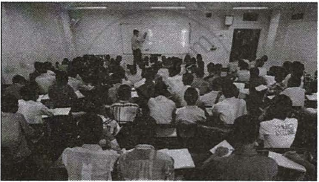Advertisements
Advertisements
Question
Find the value of k for which each of the following system of equations has infinitely many solutions
kx - 2y + 6 = 0
4x + 3y + 9 = 0
Solution
The given system of equation is
kx - 2y + 6 = 0
4x + 3y + 9 = 0
The system of equation is of the form
`a_1x + b_1y + c_1 = 0`
`a_2x + b_2y + c_2 = 0`
Where `a_1 = k, b_1 = -2,c_1 = 6`
And `a_2 = 4, b_2 = -3,c_2 = 9`
For a unique solution, we must have
`a_1/a_2 = b-1/b_2 = c-1/c_2`
`=>k/4 = (-2)/(-3) = 6/9`
Now
`k/4 = 6/9`
`=> k/4 = 2/3`
`=> k = (2xx4)/3`
`=> k = 8/3`
Hence, the given system of equations will have infinitely many solutions, if `k = 8/3`
APPEARS IN
RELATED QUESTIONS
Solve for x and y:
2x - `(3y)/4 = 3 ,5x = 2y + 7`
Solve for x and y:
`5/(x+1) + 2/(y−1) = 1/2, 10/(x+1) - 2/(y−1) = 5/2, where x ≠ 1, y ≠ 1.`
Solve for x and y:
`44/(x+y) + 30/(x−y) = 10, 55/(x+y) - 40/(x−y) = 13`
Solve for x and y:
`(bx)/a + (ay)/b = a^2 + b^2, x + y = 2ab`
5 chairs and 4 tables together cost ₹5600, while 4 chairs and 3 tables together cost
₹ 4340. Find the cost of each chair and that of each table
A number consisting of two digits is seven times the sum of its digits. When 27 is subtracted from the number, the digits are reversed. Find the number.
The sum of a two-digit number and the number obtained by reversing the order of its digits is 121, and the two digits differ by 3. Find the number,
The sum of the numerator and denominator of a fraction is 8. If 3 is added to both of the numerator and the denominator, the fraction becomes `3/4`. Find the fraction.
The denominator of a fraction is greater than its numerator by 11. If 8 is added to both its numerator and denominator, it becomes `3/4`. Find the fraction.
Read the following passage:
|
A coaching institute of Mathematics conducts classes in two batches I and II and fees for rich and poor children are different. In batch I, there are 20 poor and 5 rich children, whereas in batch II, there are 5 poor and 25 rich children. The total monthly collection of fees from batch I is ₹9,000 and from batch II is ₹26,000. Assume that each poor child pays ₹x per month and each rich child pays ₹y per month.
|
Based on the above information, answer the following questions:
- Represent the information given above in terms of x and y.
- Find the monthly fee paid by a poor child.
OR
Find the difference in the monthly fee paid by a poor child and a rich child. - If there are 10 poor and 20 rich children in batch II, what is the total monthly collection of fees from batch II?

